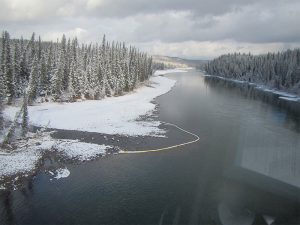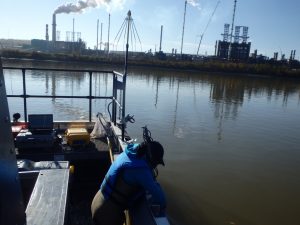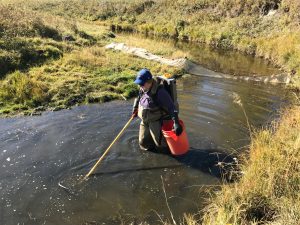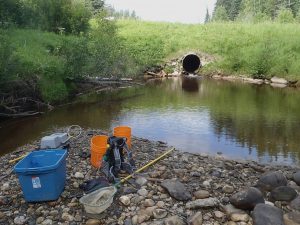Sustainable Resource and Land-Use Development
Research
Meeting the societal need for resource (e.g. oil and gas, timber) and land-use development while maintaining environmental sustainability can be challenging. As the human population grows, so does the need for resource and land-use development for that population. Developing sustainable development remains a global challenge. We strive to help assess and improve sustainable development in relation to aquatic ecosystems. For example, industrial activities related to the exploration and development of natural resources have created large networks of roads that we've shown to negatively impact aquatic ecosystems (Maitland et al. 2016a). Prioritization methods that consider at-risk species can help mitigate problem these problem stream crossings (Maitland et al. 2016b). Other projects include: assessing the impact of oil sands development on aquatic ecosystems (Donner et al. 2018; Shotyk et al. 2018; Sun et. al. 2017), assessing spills and determining bio-accumulation of metals in aquatic ecosystems. Click on the photos, articles or news items to learn more about some of the research we are conducting on sustainable resource development! Note: * Lab members.
Articles from Lab

Hambrook J., Kimmel N., Robinson R., Foster D., Poesch M.S. and P. Hanington. (2025) Development, validation and implementation of eDNA-focused qPCR assays to detect and distinguish between Goldfish (Carassius auratus) and Prussian Carp (Carassius gibelio). Environmental DNA 7(2): e70092.

Veilleux, H., McPherson, M.*, Cott, P., Poesch, M., S., Glover, C., and G. Goss. (2025) Environmental DNA as a tool to detect Arctic grayling and their habitat preferences in the Northwest Territories, Canada. Arctic Science 11: 1-12.

Miller, M., Stevens, C. and M. S. Poesch. (2025). Effectiveness of spawning substrate enhancement for adfluvial fish in a regulated sub-Arctic river. River Research and Applications 41(2): 412-425.

Pandit, S.*, Poesch, M. S., Kolasa, J., Pandit, L. K., Ruppert, J. L. W., and E. Enders (2024). Long-term evaluation of the impact of urbanization on native and non-native fish assemblages. Aquatic Invasions: 19(3): 345-360.

Theis S.*, Cartwright L., Chreston A., Coey B., Graham B., Little D., Poesch M.S., Portiss R., Wallace A. and J. L. W. Ruppert (2024). A multi-metric index for assessing two decades of community responses to broad scale shoreline enhancement and restoration along the Toronto waterfront. Aquatic Conservation: Marine and Freshwater Ecosystems 34: e24141.
News from the Lab

Theis, S.*, Shirton, J.*, Barbeau, M.*, Ruppert, J. W. L.* and M.S. Poesch (2025) Growth and diet of Northern Pike (Esox lucius) in Boreal lakes: Implications for Ecosystem Management. Hydrobiologia 4(1): 1.

Miller, M., Stevens, C. and M. S. Poesch. (2025). Effectiveness of spawning substrate enhancement for adfluvial fish in a regulated sub-Arctic river. River Research and Applications 41(2): 412-425.

Theis S.* and M. S. Poesch. (2024). What makes a bank a bank? Differences and commonalities in credit calculation, application, and risks in mitigation banks targeting freshwater fish species and associated ecosystems. Environmental Management: 73(1): 199-212.




